
On this day, August 22, 2002, President George W. Bush proposed to end the government's "hands-off" policy in national forests and ease logging restrictions in fire-prone areas.
Also on this day, August 22, 2014, the State of Oregon filed a $200 million suit against Oracle Corp. and several executives over the company's role in creating the troubled website for the state's online health insurance exchange.
Also on this day, August 22, 2020, demonstrators faced off in Portland with the two sides -- one aligned with a "Back the Blue" rally and the other a Black Lives Matter counter-demonstration -- reportedly largely ignoring police warnings. Ultimately, Department of Homeland Security officers deemed the gatherings unlawful and moved through the plaza, forcing the crowd to disperse.
 Post an Event
Post an Event
| Benton County Republicans’ Private Fundraising Event, “Bent-on Boots and Bling” with Trey Taylor |
| Friday, September 5, 2025 at 5:00 pm |
| Featuring Trey Taylor
Music Private Event
Friday, September 5, 2025 5:00-5:30 pm VIP Reception
5:30-8:00 pm Heavy Appetizers,
Auction, Concert
Red: $750 VIP Reception
Front Row Table Sponsor
White: $500 Table Sponsor
Blue: $50 per person
Limited Seating. Get Yours Now!!!
Support Local
Dress up: Bling, Cowboy, Patriotic Benton County Republican
FUNDRAISER
www.BentonGOP.org
Get your tickets today at:
https://www.bentongop.org/event-details/benton-county-republicans-fundraiser/form
About Trey:
Trey is the youngest African American Man in Country Music History. The Denver Post wrote
"It's impossible to miss his enthusiasm. With a fondness for cowboy boots, gaudy colors and dazzling jewelry, Trey Taylor could stand toe to toe with any of the Pop, Country or even Rap
contemporaries of his generation.“ |
| Trysting Tree Golf Club, 34028 NE Electric Rd., Corvallis |
It might not be helping Oregon
Senator Merkley recently introduced a pair of bills to reduce the use of fossil fuels claiming it protects the long-term health and well-being of the American people and their economy from the catastrophic effects of climate chaos, by tackling the risky financial investments.
- The Protecting America’s Economy from the Carbon Bubble Act of 2020 would help safeguard the economy by prohibiting financial companies from making new investments in fossil fuels
- The Sustainable International Financial Institutions Act of 2020 would elevate that priority to the international stage by ensuring that the United States uses its voice and vote in international financial institutions to divest from fossil fuel investments.
- Senator Merkley also introduced legislation to abolish the Electoral
College as part of a package of election reform bills. Since this move
would reduce the influence of Oregon voters, one might ask who he is
representing.
- Senator Merkley and Representative Mike Levin (D-CA) introduced in
October the Zero-Emission Vehicles Act of 2020 to address climate
chaos by ending American sales of new gasoline-powered vehicles in 15
years. He went so far as blaming gasoline engines may also increase
mortality among coronavirus patients in a news release.
- Senator Merkley signed his support to the Green New Deal and is taking
his pledge seriously by introducing numerous bills to combat the
climate chaos. Intentionally working against the administration and
accomplish something that will be signed by the President, can we say
we have representation?
A D V E R T I S E M E N T
A D V E R T I S E M E N T
Merkley’s voting record
- S.311 - Born-Alive Abortion Survivors Protection Act to prohibit a health care practitioner from failing to exercise the proper degree of care in the case of a child who survives an abortion or attempted abortion.
- A bill to amend title 18, United States Code, to prohibit a health care practitioner from failing to exercise the proper degree of care in the case of a child who survives an abortion or attempted abortion. Merkley voted NO
- S.1 - Keystone XL Pipeline Approval Act. A bill to approve the KeystoneXL Pipeline. Merkley voted NO
- Vote to proceed on S.178; A bill to condemn gross human rights violations of ethnic Turkic Muslims in Xinjiang, and calling for an end to arbitrary detention, torture, and harassment of these communities inside and outside China. Merkley voted NO
- S. 4049, As Amended; An original bill to authorize appropriations for fiscal year 2021 for military activities of the Department of Defense, for military construction, and for defense activities of the Department of Energy, to prescribe military personnel strengths for such fiscal year, and for other purposes. Merkley voted NO, but 86-14 passed
- No. 1972, As Modified; To expand the list of diseases associated with exposure to certain herbicide agents for which there is a presumption of service connection for veterans who served in the Republic of Vietnam. Merkley voted YES, and it passed 94-6
- No. 2244; To restore American leadership in semiconductor manufacturing by increasing federal incentives in order to enable
advanced research and development, secure the supply chain, and ensure long-term national security and economic competitiveness.
Merkley voted YES and it passed 96-4
- No. 2411; To impose additional conditions and limitations on the transfer of Department of Defense property for law enforcement
activities. Merkley voted YES and it passed 90-10
- S. 3985; A bill to improve and reform policing practices, accountability, and transparency. Merkley voted NO and it passed 55-45
- H.R. 1957 As Amended; To amend title 54, United States Code, to establish, fund, and provide for the use of amounts in a National Parks and Public Land Legacy Restoration Fund to address the maintenance backlog of the National Park Service, the United States Fish and Wildlife Service, the Bureau of Land Management, the Forest Service, and the Bureau of Indian Education, and to provide permanent, dedicated funding for the Land and Water Conservation Fund, and for other purposes. Merkley voted YES and it passed 73-25
- No. 1586; To amend the Foreign Intelligence Surveillance Act of 1978 to prohibit the use of authorities under such Act to surveil United States persons and to prohibit the use of information acquired under such Act in any criminal, civil, or administrative proceeding or as part of any criminal, civil, or administrative investigation, and for other purposes. Merkley voted NO and it failed 11-85
- No. 1583; To remove internet website browsing information and search history from scope of authority to access certain business records for foreign intelligence and international terrorism investigations. Merkley voted YES and it passed 59-37
- H.R. 748 As Amended; A bill to amend the Internal Revenue Code of 1986 to repeal the excise tax on high cost employer-sponsored health coverage. Merkley voted YES and it passed 96-0
- HR 748 Amdt No.1577; To ensure that additional unemployment benefits do not result in an individual receiving unemployment
compensation that is more than the amount of wages the individual was earning prior to becoming unemployed. Merkley voted NO and the bill failed.
- HR 6201 Amdt. No.1558; To strike Federally mandated sick pay and paid family leave and replace it with financial support provided through State administered unemployment insurance systems and funds. rejected. Merkley voted NO and it failed 50-48
- S. 2657; A bill to support innovation in advanced geothermal research and development, and for other purposes. Merkley voted YES and it passed 84-3
- Motion to Waive All Applicable Budgetary Discipline Re: H.R. 5430; A bill to implement the Agreement between the United States of
America, the United Mexican States, and Canada attached as an Annex to the Protocol Replacing the North American Free Trade Agreement. Merkley voted YES and it passed 75-23
- Amdt. No. 2244; To restore American leadership in semiconductor manufacturing by increasing federal incentives in order to enable
advanced research and development, secure the supply chain, and ensure long-term national security and economic competitiveness. Merkley voted YES and it passed 96-4
--Donna Bleiler| Post Date: 2020-11-24 11:57:27 | Last Update: 2020-11-24 21:12:41 |
Does the Brown administration have a double standard for Christian schools?
In one of the many case in which Oregon Governor Kate Brown is being sued by private parties over her COVID-19 policies, one of the issues being raised is why are private schools -- specifically Christian schools -- suffering extra scrutiny? In the case of
Horizon Christian School v. Kate Brown, the answer to that question may rest on a comment made by Leah Horner, who is an advisor to Governor Kate Brown on Jobs and the Economy.
As advisors to the Governor were
depositions, their testimony is telling regarding the position of the Brown Administration toward private, Christian schools and how they regard teachers' unions.
The flap started when Yamhill County Commissioner Mary Starrett made a post in facebook where she commented on a conversation she had with the an unnamed member of the Governor's staff on "why private, parochial and faith-based schools were not being allowed to open once they’d submitted their plans to keep kids safe." The commissioner reports that the advisor to the Governor said, "We don’t want to see a mass exodus from the public schools." It turns out that the advisor was Leah Horner, who is Governor Brown's advisor on Jobs and the Economy.
The comment is not only significant in that it shows the Brown Administration's disregard for the outcomes of all children, but it's an indication that private, Christian schools are being held to a different standard for the purpose of protecting public schools and public employee unions. The evidence is not only in what the witnesses say, but in how evasive they are.
In this deposition, the questions are being asked by John Kaempf, attorney for plaintiffs and the person being deposed is Lindsey Capps, the Governor’s Chief Education Officer:
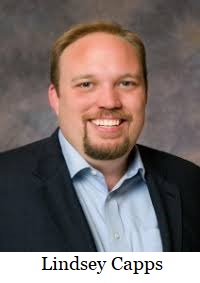
Q. Beyond the general concern, isn't it true that one or more school districts have been concerned about a mass exodus from the public schools if private or religious schools are allowed to reopen?
A. I don't recall ever hearing that from a specific district around private schools.
Q. Did you ever hear that in any context related to the pandemic?
A. Not that I recall.
Q. Now isn't it true that on July 9 of 2020, after the Wall Street Journal opinion article that we've talked about was published, that Leah Horner, an economic policy advisor to the governor, used the identical concern and raised the identical concern about a quote, "mass exodus from public schools," end quote?
A: I was not aware of any comments on her part.
Q. Have you seen the declaration of Yamhill County Commissioner Mary Starrett in this case?
A. I have seen communication from the commissioner. I'm not sure of which one you are stating.
Q. I'll represent to you that she testified that on July 29, 2020, Leah Horner did state a concern about a mass exodus from public schools if parochial schools are allowed to reopen. Do you know if that is true or not, that Ms. Horner made that statement?
A. I don't know if that's true.
Q. To your knowledge, is Governor Brown concerned about a mass exodus from public schools if private or religious schools are allowed to reopen for in-person classes?
A. Not to my knowledge.
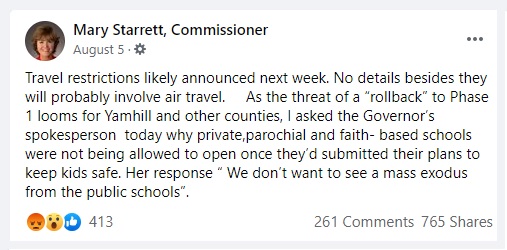 Q. Now getting back to the Wall Street Journal editorial we've been talking about, it also states in reference to teachers unions that, quote, "under pressure from the unions, the Oregon Department of Education stopped allowing transfers on March 27," end quote. Is that true? What I want to know is, first, did you ever get pressure from the teachers unions to stop allowing transfers out of public schools?
Q. Now getting back to the Wall Street Journal editorial we've been talking about, it also states in reference to teachers unions that, quote, "under pressure from the unions, the Oregon Department of Education stopped allowing transfers on March 27," end quote. Is that true? What I want to know is, first, did you ever get pressure from the teachers unions to stop allowing transfers out of public schools?
A. No.
Q. Did the Oregon Department of Education ever stop allowing transfers out of public schools to charter or private schools?
A. No, there's still a process in place.
Q. The Wall Street Journal editorial we're talking about references an Oregon Department of Education March 24, power point presentation. Do you know what that is?
A. I do not.
Q. You ever heard anything about that March 24 power point presentation?
A. I don't know the presentation to which you are speaking.
Q. Back to the Wall Street opinion piece, it also states, quote, "even during a national crisis, unions would rather deprive students of an education than see their charter school competitors succeed," end quote. Do you agree?
A. I believe you are asking me do I agree with the opinion of the Wall Street Journal?
Q. That specific statement, do you agree, yes or no?
A. I think it's a simple statement, overly simplistic.
Q. Do you agree with it or disagree with it?
A. I don't know how to answer either way.
Q. Are you aware of whether this Wall Street Journal editorial board opinion sparked the concern among any members of the Governor's staff?
A. Not that I'm aware of.
A D V E R T I S E M E N T
A D V E R T I S E M E N T
Q. To this day, does that Wall Street Journal opinion concern you?
A. I think the overriding concern for me is to continue to serve students as effectively and safely as we can during this pandemic.
Q. I'm talking about the Wall Street Journal article. Does it concern you as you sit here today?
A. I can't speak to that.
Q. To your knowledge, did that Wall Street Journal article concern Governor Brown?
A. No, not that I'm aware of.
Q. Did you ever discuss it with her?
A. No.
Q. In a text message dated April 1 of 2020, Nik Blosser immediately after providing the link to this Wall Street Journal article we've been talking about, he wrote, quote, "Sent you and GKP some quick talking points for the 1:30 call," end quote? Do you recall that?
A. Without further context, I don't.
Q. This text message that's labeled 004171 from April 1st of 2020 is written by Nike Blosser. Do you recall receiving a text to that effect about needing to have a 1:30 call and quick talking points about the Wall Street Journal article?
A. I don't recall the interaction.
Q. Do you ever recall a 1:30 call on April 1st of 2020, the day after that Wall Street Journal opinion article?
A. I don't but we've never discussed that topic.
Q. In an April 2nd, 2020 text message, Nik Blosser wrote, and I can't tell who he wrote it to, it says, quote, "please give me a call when you can, urgent," end quote. Do you recall getting that text message?
A. No.
Q. In that same text message Nik Blosser provides a link to a breitbart.com article dated April 2 of 2020, the same day as the text message. And it's entitled, quote, "teachers unions pressure on states to clamp down on virtual charter schools during pandemic," end quote. Do you recall ever seeing that breitbart.com article about teachers unions pressure?
A. Generally in the public square.
Much later in the deposition, the conversation with Lindsey Capps about Horner's comment about "Mass Exodus" continues. Despite Yamhill County Commissioner Mary Starrett's facebook post, the "mass exodus" comment and the substantive fact of the danger to public schools is either denied or not remembered.
Q. Did you suggest or order anything be done concerning what Ms. Horner said about the mass exodus from public schools, at least according to Ms. Starrett?
A. No.
Q. Did you ever talk to Leah about Ms. Starrett's contention that she made that mass exodus from public schools statement?
A. I did not speak to her.
Q. To your knowledge, has Leah Horner admitted that those words came out of her mouth on July 29?
A. No.
Q. Are you pleased or displeased that Ms. Horner may have said that?
A. I would just say that it's not the place of a state to articulate a position toward public or private school. Our emergency authority applies to both.
Q. Was Leah Horner disciplined in any way for supposedly making that statement?
A. Not that I'm aware of.
Jody Christensen, the Mid-Valley Regional Solutions Coordinator for the Governor's Office was also deposed regarding her recollection of conversations concerning the threat to public schools. Again, she denies knowledge of the comment -- including speaking with Leah Horner about it -- and the underlying issue of the threat to public schools.
Q. At any time this year have you ever heard or seen Governor Brown express a concern about a significant amount of students leaving public schools because of the pandemic?
A. No.
Q. Have you ever heard or seen Lindsey Capps make any statement like that?
A. No.
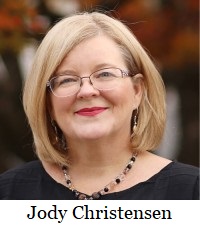 Q. Have you ever heard Leah Horner make any statement or write any statement like that?
Q. Have you ever heard Leah Horner make any statement or write any statement like that?
A. The term "mass exodus" was used during the August 5th meeting.
Q. Was any other phrase like that ever used by Leah Horner this year?
A. No.
Q. Okay. And did you ever hear any other person who works for the Oregon government express any concern, whether it was mass exodus or just saying worried, about a large amount of kids leaving public schools because of the pandemic?
A. No.
Q. Okay. So did [Yamhill County] Commissioner Kulla ever express a concern like that?
A. I don't recall.
Q. Do you recall any county commissioner ever expressing that concern in any conference call you attended this year?
A. I don't recall.
Q. All right. Do you recall any Oregon politician expressing any concern like that in any kind of writing, like an email or a text message?
A. I don't recall.
Q. Have you ever personally been concerned about a large amount of students leaving public schools during the pandemic?
A. No.
Jody Christensen's deposition about Horner's remark continued after more testimony. The denials continue.
Q. All right. Are you aware of anyone in Oregon's government at any time this year expressing a concern about a large amount of students leaving public schools?
A. I am not aware.
Q. Do you know whether that topic has ever been the subject of any written report within the Oregon government?
A. I am not aware.
Q. Have you ever helped to create or ever read a report showing the possible financial effects of students leaving public schools for private schools during the pandemic?
A. No.
Q. Before this August 5th meeting we're talking about, where you testified Ms. Horner used the phrase "mass exodus," had you ever heard that phrase come up before in any county commissioner meeting?
A. No.
Q. Had you ever seen that phrase in writing before the August 5th meeting related to the pandemic?
A. No.
Q. Have you ever used the phrase "mass exodus" in relation to the pandemic?
A. No.
Q. Are you aware of anyone else in Oregon's government who's used that term this year, relating to the pandemic?
A. No.
Q. Now, in the declaration that Ms. Horner filed in this case that's, you know, written testimony, she says that when she made the mass exodus statement she says, quote, [as read:] I had been discussing a concern that had been raised in another call about the potential loss to an educational institution of state school funds if students were disenrolling from such a school, end quote. Do you recall Ms. Horner that day making a reference to another call about the potential loss to an educational institution?
A. I don't recall that.
At this point, based on the testimony of two of Governor Brown's staffers, one might conclude that the phrase "mass exodus" was not used -- save for the August 5th meeting -- and/or that there was no concern for public school loss of enrollment. The deposition of Leah Horner, herself tells a different tale.
Q. During what you're saying is the August 5th conference call with county commissioners, did Mary Starrett, a Yamhill County commissioner, ask you why parochial schools were not being allowed to reopen?
A. I don't recall that specifically, but she has asked those -- she did ask a question along those lines.
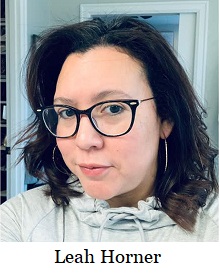 Q. Okay. And as best you can recall, what questions did she ask along that line?
Q. Okay. And as best you can recall, what questions did she ask along that line?
A. I believe she had asked if private, religious schools would have the opportunity to operate under different guidance than the K-12 public school system.
Q. And what did you say in response to that question?
A. I believe my response was no, that all schools would be falling under one statewide Department of Education guidance.
Q. Did you say in response to that question from Mary Starrett that there was a concern about a mass exodus from public schools if private or religious schools were allowed to reopen?
A. I did use the term there would -- there could be a mass exodus from public schools. But it was not in the context directly correlated to private or religious schools. It was also in the context of school disenrollment for children moving to online schools, virtual schools, charter schools, and it was in correlation to the fact that disenrollment from public schools modifies the school funding methodology. And in previous conversations that I had had that week with other county commissioners, they were unaware of what that disenrollment from public school does to their school -- their share of the state school fund, and so I was sharing that as a point of information.
Q. And I understand you're saying that context is different. But I just want to confirm, isn't it true, then, that during this meeting you say was on August 5th that Mary Starrett and others attended, you did -- the words, quote [as read:] mass exodus from public schools did come out of your mouth, end quote.
A. Yes.
A D V E R T I S E M E N T
A D V E R T I S E M E N T
Q. Do you recall what Mary Starrett said in response to you saying there would be a mass exodus from public schools?
A. I do not recall.
Q. Before today, have you read Mary Starrett's declaration?
A. I do not recall.
Q. Okay. Paragraph two of the declaration you filed in this case says that you have read it, Mrs. Starrett's declaration. Does that refresh your recollection?
A. Yes, it does to some degree. That's why I indicated I did not recall because I feel I probably did read it at some point, but I don't have it fresh in my mind.
Q. Okay. How did you feel when you read it given that it's fairly short and specifically talks about you?
A. Again, I don't -- I honestly don't recall reading it.
Q. Okay. I don't want to know about conversations with your lawyer, the governor's lawyers, that's legally none of my business. But what I do want to know is, did you talk about Mary Starrett's declaration with anyone on the governor's staff ever? If it involved lawyers, I don't want to know that. But I want to know of people who are not lawyers that you worked with, for example, Jody Christensen, people like that, did you ever with such people, nonlawyers, discuss Mary Starrett's declaration in this case?
A. Yes.
Q. Who did you discuss that with?
A. I discussed that with Jody Christensen.
Q. And was that in writing or verbally or both?
A. Verbally. It was verbally.
Q. And what was Jody's reaction? What did she say when you discussed that?
A. I think Jody and I were trying to recall the conversation, and we both recollected very similar statements that were had on that call.
Q. Did Jody say to you, in so many words, that yes, she recalled that you did use the phrase "mass exodus" from public schools?
A. I don't know if Jody used that phrase, but I recall using that phrase. And so I offered that up as part of the conversation with Jody.
Q. Because you do recall that.
A. Yes.
Again, this is significant because it may indicate that Governor Brown and her administration have more concern for the teachers' unions than they do for the children of the State of Oregon.
--Staff Reports| Post Date: 2020-11-23 19:47:10 | Last Update: 2020-11-23 21:36:55 |
Governor Kate Brown will appoint replacements
Governor Kate Brown has
announced that she intends to fill two judicial vacancies created by the planned retirement of Judge Ilisa Rooke-Ley from the Lane County Circuit Court, and the planned retirement of Judge Claudia Burton from the Marion County Circuit Court. Both retirements will take effect December 31, 2020.
The Governor’s Office currently is conducting an appointments process for Marion County to fill the vacancy created by the previously announced retirement of Judge Mary Jame. Applicants that applied for that position also will be considered for the vacancy created by Judge Burton’s retirement. Governor Brown will fill both Marion County vacancies from the same applicant pool. That list of candidates is available on the Oregon State Bar’s
website .
All judges on Oregon who retire in the middle of their terms, are replaced by gubernatorial appointment. Ordinarily, they are elected. There is a ballot measure proposed for the 2022 general election
which proposes to replace judges at the next election by a vote of the people. This measure is still seeking enough signatures to get an official ballot title.
A D V E R T I S E M E N T
A D V E R T I S E M E N T
Last summer, there was a prior judicial vacancy on the Lane County Circuit Court for which candidates were interviewed and vetted by the Governor's Office and the local bar association. Governor Brown will make an appointment for the current Lane County vacancy from the list of candidates who applied and were interviewed previously. That list of candidates also is available on the Oregon State Bar’s website .
Comments on any of the candidates can be
submitted online to Dustin Buehler, General Counsel, Office of the Governor, or by phone at 503-378-6246
--Ben Fisher| Post Date: 2020-11-23 19:43:05 | Last Update: 2020-11-23 21:26:12 |
Similar Ban Passed in Oregon in 2015
The U.S. Court of Appeals for the
11th Circuit issued a decision that strikes down bans on therapy for minors struggling with unwanted same-sex attraction, saying such bans violate the First Amendment of the U.S. Constitution. Bans on conversion therapy have been upheld in the 9th and 3rd Circuits, creating a split among them and a possible path to the US Supreme Court, which has previously declined to hear these cases. The decision states, “We hold that the challenged ordinances violate the First Amendment because they are content-based regulations of speech that cannot survive strict scrutiny.†The Cities of Boca Raton and Palm Beach County, Florida ordinances apply to “any person who is licensed by the State of Florida to provide professional counseling,†except for clergy.
The plaintiffs, therapists Robert W. Otto and Julie H. Hamilton, are licensed marriage and family therapists who provide counseling to minors who have unwanted same-sex attraction or unwanted gender identity issues. The case and decision were based on content-based restrictions on speech.
While the plaintiffs argue a lack of freedom to speak with their clients that brings out a certain amount of discrimination, it avoids the lopsided treatment of one therapy over another. Both ordinances banned “conversion therapy†but allowed trans-affirmative therapy and counseling that provides support and assistance to a person undergoing gender transition.
In 2015, Oregon became the third state to ban Conversion Therapy on minors after then President Obama called for the ban. In calling for the ban, barbaric and unethical practices were cited that were no longer being practiced. Nonetheless, Oregon joined California, New Jersey and Washington D.C. in prohibiting licensed therapists from attempting to encourage sexual orientation or gender identity that is biological to a child. This came after the Supreme Court declined to hear challenges in California and New Jersey, leaving in place a decision that upheld the ban.
A D V E R T I S E M E N T
A D V E R T I S E M E N T
Governor Brown signed
ORS 675.850 into law without fanfare prohibiting the practice of conversion therapy (reparative therapy). The law “prohibits mental health care professionals and social health professionals from providing any service to person under 18 years of age for purpose of attempting to change person's sexual orientation or gender identity.†Equality and Justice for All
testified to the lopsidedness of
HB 2307, passed in 2015, allowing sexual orientation change effort therapy while prohibiting conversion therapy. They cite a 100-year scientific research of a comprehensive review of SOCE documenting success that shows that therapy has helped some clients resolve their unwanted same-sex attraction and experience heterosexual attractions.
The case ruled as unconstitutional in federal court is very similar to Oregon law. Where does Oregon legislative leadership hold the “total care†of children, and will we see a reversal in the 2021 legislative session?
Photo by Bill Mason on Unsplash.com
--Donna Bleiler| Post Date: 2020-11-23 07:49:28 | Last Update: 2020-11-23 15:27:44 |
New renewable energy reduces the need for cap-and-trade
As Governor Brown and other leaders continue to speak about climate change to push their cap-and-trade in the 2021 session, Portland General Electric counters the need for cap-and-trade with new renewable energy.
PGE has announced a
new hydroelectric project powered entirely by excess water pressure. Traditional hydroelectric projects are nothing new across the state, and PGE owns or partially owns seven hydro facilities on the Clackamas, Willamette, and Deschutes Rivers. The City of Hillsboro is pioneering an
innovative micro-hydropower system called the In-PRV that manages pressure in a city water pipeline while generating renewable energy, reducing carbon, saving water, extending the life of infrastructure and improving resilience.
“The major difference†says PGE, “comes from how the system is being integrated into the city of Hillsboro’s existing hydro infrastructure. Instead of the roaring falls at the Bonneville Dam, this new technology captures the waste pressure produced inside the pipe from the constant flow of water – using a new kind of pressure reducing valve to harness that wasted energy and turn it into reliable, renewable electricity. And unlike many other forms that are dependent upon weather, the flow at this system runs 24/7, allowing additional resiliency for the grid.â€
A D V E R T I S E M E N T
A D V E R T I S E M E N T
Located just outside of the Hillsboro Hops stadium, the approximately 200,000 kWh generated annually from this site will add to
PGE’s Renewable Development Fund’s growing portfolio of over 14.5 MW of installed renewable projects.
If the state didn’t require new energy projects to include expensive sources of wind and solar, these new innovations could reduce energy cost while effectively reducing the impact on climate change.
--Donna Bleiler| Post Date: 2020-11-22 16:36:43 | Last Update: 2020-11-23 15:43:35 |
It remains to be seen how she will decide on election results in Arizona and Nevada.
The Honorable John G. Roberts, Jr., Chief Justice of the US Supreme Court,
released the assignments for the 13 federal circuit courts of appeals reappointing Justice Elena Kagan to the 9th district court effective November 20, 2020. Each Justice is responsible for emergency applications and other matters from one or more of these circuits. Justices can and often do refer significant emergency requests to the full court. Justices may also be asked to halt the implementation of a circuit court order, set bond for a defendant, or stop the deportation of an alien. Justices are also asked to act on applications for a stay of execution.
In August 2018, Chief Justice John Roberts had assumed responsibility for the 9th Circuit, which covers nine states (Alaska, Arizona, California, Hawaii, Idaho, Oregon, Montana, Nevada and Washington) plus Guam and the Northern Mariana Islands. Justice Elena Kagan took over the 9th Circuit in October 2018. Kagan, appointed by President Obama in 2010, is a native New Yorker who has spent most of her adult life in Chicago, Massachusetts and DC. Known for her strategic influence, her claim as being fair and impartial is spoiled by her many unexpected rulings. She is undeniably part of the liberal wing of the court. Kagan has made a name for herself as being a “bridge-builder.†It remains to be seen how she will respond to President Trump’s lawsuits contesting election results in Arizona and Nevada.
Recently, Kagan’s 9th Circuit Court declined to grant a motion by the Oregon Department of Justice to halt signature gathering for Initiative Petition 57 that would qualify it for the November ballot due to the pandemic restrictions. It would have changed the way Oregon redraws legislative boundaries.
A D V E R T I S E M E N T
A D V E R T I S E M E N T
Assignments are made pursuant to
Title 28, United States Code, Section 42 the Chief Justice of the United States and the associate justices of the Supreme Court shall from time to time be allotted as circuit justices among the circuits by order of the Supreme Court. The Chief Justice may make such allotments in vacation.
- For the District of Columbia Circuit - John G. Roberts, Jr., Chief Justice
- For the First Circuit - Stephen Breyer, Associate Justice (Maine, Massachusetts, New Hampshire, Puerto Rico, Rhode Island)
- For the Second Circuit - Sonia Sotomayor, Associate Justice (Connecticut, New York, Vermont)
- For the Third Circuit - Samuel A. Alito, Jr., Associate Justice (Delaware, New Jersey, Pennsylvania, Virgin Island)
- For the Fourth Circuit - John G. Roberts, Jr., Chief Justice (Maryland, North Carolina, South Carolina, West Virginia, Virginia)
- For the Fifth Circuit - Samuel A. Alito, Jr., Associate Justice (Louisiana, Mississippi, Texas)
- For the Sixth Circuit - Brett M. Kavanaugh, Associate Justice (Kentucky, Michigan, Ohio, Tennessee)
- For the Seventh Circuit - Amy Coney Barrett, Associate Justice (Illinois, Indiana, Wisconsin)
- For the Eighth Circuit - Brett M. Kavanaugh, Associate Justice (Arkansas, Iowa, Minnesota, Missouri, Nebraska, North Dakota, South Dakota)
- For the Ninth Circuit - Elena Kagan, Associate Justice (Alaska, Arizona, California, Guam, Hawaii, Idaho, Oregon, Montana, Nevada, Northern Mariana Islands, Washington)
- For the Tenth Circuit - Neil M. Gorsuch, Associate Justice (Colorado, Kansas, New Mexico, Oklahoma, Utah, Wyoming)
- For the Eleventh Circuit - Clarence Thomas, Associate Justice (Alabama, Florida, Georgia)
- For the Federal Circuit - John G. Roberts, Jr., Chief Justice.
 --Donna Bleiler
--Donna Bleiler| Post Date: 2020-11-22 06:58:51 | Last Update: 2020-11-23 15:44:16 |
How the people of Oregon have voted themselves out of power

On November 6th of 2012 the Voters of Oregon passed measure 77, the ballot title and summary were written by then Secretary of State Kate Brown, and Treasurer Ted Wheeler. The measure amended the State Constitution to grant emergency powers to the Governor and the Legislature during a period of time defined as a "Catastrophic Disaster", defined here as; a natural or human-caused event
resulting in extraordinary levels of death, injury, property damage or disruption of daily life and severely affecting the population, infrastructure, environment, economy or government of Oregon. The terms “extraordinary levels†and “severely affects†are not defined (emphasis added). Examples include, but are not limited to, acts of terrorism, earthquakes, floods, public health emergencies, tsunamis, volcanic eruptions and war. If the Governor declares that a catastrophic disaster has occurred, the Governor may manage immediate response to the disaster by:
- Redirecting general fund moneys for state agencies.
- Using only lottery funds allocated to state agencies.
If the Governor declares that a catastrophic disaster has occurred, the Governor also must convene the Legislature
within 30 days. The Legislature may:
- Meet at a place other than the Capitol or by electronic means.
- Conduct business and suspend rules with two-thirds of the members able to attend, instead of two-thirds of all members.
- Pass bills with three-fifths of the members who are able to attend, instead of a majority of all members.
- Pass tax bills that take effect upon passage instead of 90 days after the Legislature adjourns.
The Legislature may take additional actions otherwise prohibited by the Oregon Constitution and are limited to actions
necessary to implement immediate response and aid in recovery. The Legislature may:
- Spend State Highway Fund moneys (gas taxes) for any purpose.
- Spend moneys that otherwise would go to individual and corporate tax “kicker†refunds by vote of 2/3 of members able to attend.
- Exceed the state debt limit.
- Override funding of local mandate provisions.
- Spend any lottery funds.
Speaker of the House Tina Kotek -D Portland, is
calling on Governor Kate Brown to declare a "Catastrophic Disaster", and bring the legislature into a special session this December. In Kotek's press release, she states "The COVID-19 pandemic is raging like never before in Oregon. Our economic recovery is fully dependent on getting this virus under control". Side Note: "Under control" has been further defined as a need for federal aid, and vaccine administration in other statements.
A D V E R T I S E M E N T
A D V E R T I S E M E N T
A special session can be called at any time by the Governor, or a majority in both chambers is also authorized to organize a special session. So why is it so important to declare a "Catastrophic Disaster"? As outlined above, during a catastrophic disaster, quorum requirements relax, making, previously seen, pushback against
poorly written and ill conceived bills, impossible. In addition to blocking pushback from the minority party, a declared catastrophic disaster would also allow the legislature to spend kicker checks, (typically refunded to overcharged taxpayers) spend the lottery funds, spend the highway fund, and if that's not enough, exceed the debt limit allowed to the state.
How did we allow this to happen, you might be asking? According to Justin Brecht the Senate Minority Senior Policy Analyst
"Ballot titles and the description are often confusing, and written by the supermajority".
The legislature has been criticized for crying wolf on emergencies. In 2016, measure 88 failed to gather enough signatures to make the ballot. The measure would have ended the overused "Emergency Clause". No act shall take effect,†stipulates Oregon’s constitution, “until ninety days from the end of the session at which the same shall have been passed, except in case of emergency; which emergency shall be declared in ... the law.†Why wait 90 days? 90 days is the amount of time needed to gather signatures in order to overturn a bill by the referendum process. Webster’s defines “emergency†as “an urgent need for assistance or relief, yet by 2012 seventy one percent of all bills passed, did so with an Emergency Clause, ranging from bills to allow unionization of workplaces via “check-off cards†(2007); to credential undocumented immigrants for in-state university tuition (2013); and even to replace the U.S. Capitol statue of Oregon pioneer Jason Lee with one of the late U.S. Sen. Mark Hatfield (2014).
With historical abuse of Emergencies, it's fair to ask, Are we actually dealing with an emergency, or are we looking at just another power grab?
A new effort to
curb abuse of emergencies in the legislature is now circulating, in hopes of returning the constitutionally guaranteed right of the referendum process, to the voters.
--Breeauna Sagdal| Post Date: 2020-11-22 03:24:12 | Last Update: 2020-11-23 15:45:55 |
Southern Oregon pushes back
A rally was held in Klamath Falls today against the lockdown. Speakers included State Senator Dennis Linthicum (R-Beatty), State Representative E. Werner Reschke (R-Klamath Falls) and Klamath County Commissioner Donnie Boyd, before a crowd of what some observers said was well over 100 persons, despite the chilly, windy day.
The purpose of the rally was posted on facebook.
We are rallying together to stop the senseless shutdown Kate Brown has enacted once again. Now is the time to stand up for our business owners and our community!
These lockdowns have greatly infringed upon the Constitutional rights of our communities: whereas all government derives its legitimate power from the consent of the governed!
We no longer consent to the mandates and shutdowns of our Governor!
It is our mission to send a message to Governor Kate Brown and to ask all our county leaders to stand with us to say "Enough is enough."
The "cure" has become worse than the disease and we will not stand idly by to watch another business die and suicides continue to rise in our county!
One legislator who declined to be named, described the rally as "mostly peaceful."
A D V E R T I S E M E N T
A D V E R T I S E M E N T
--Staff Reports| Post Date: 2020-11-21 21:28:47 | Last Update: 2020-11-23 15:46:20 |
And what cereal box did they get their science from?
Why on earth are we eight months into lockdowns and only now discovering the deficient testing protocols instituted by Oregon Health Authority and its director, Pat Allen? On Friday, Oregon Health Authority
announced that they would be drastically shifting the way they report tests and calculating the positivity rate of COVID-19.
The CDC uses test-based counting method which is to count all total tests administered. Up until this announcement, OHA has been using a people-based testing method. That means only counting the person instead of encounters or tests per day in the total. Oregon officials have had ample time to get this right and as a result of the latest glitch, is confidence in Oregon’s largest regulatory government agency at its lowest? The substantial lack of clarity means people will take daily reports with a grain of salt. Unfortunately, businesses are under a freeze and more is at stake than simply a lack of trust.
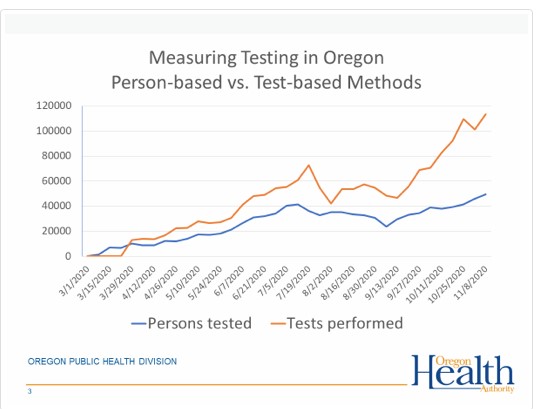
What this means and why this matters follows this important detail: Schools could have been open since early September when testing capacity was first ramped up. Schools could have been open in-person for two months as each district had to submit their reopening plans based on metrics which included statewide and county positivity rates. In September, the positivity rate for the state was 4%. If OHA had chosen to use the test-based measurement the CDC allowed for, schools could have been open. Many do not know this but once a school was in-person it could remain in-person even if community cases were increasing unless there was an outbreak in the actual school itself. OHA just removed this metric on
October 28th. Was this an early indicator that their testing methods were flawed, yet they instituted a freeze anyway?
By relying on positive cases only, instead of clinical diagnosis of actual infections, perhaps OHA wouldn’t have had to close down or do another lockdown, pause or freeze or mask mandate.
What are the different methods? Oregon has been using person-based testing. In lieu of a national standard, the Centers for Disease Control indicates there are three reasons why person based testing is done; either there is widespread infection or only a subset of a certain community is at risk of Covid-19 infection is being tested. Long term care residents or farm workers fit this description. The other reason is that there is a reporting process that skew the results. This happens when positive tests results are prioritized over negative test results. This prioritization has been prevalent daily in Oregon in the constant barrage of positive “casesâ€. Never recoveries. Never total tests administered and definitely not ever false positive rates.
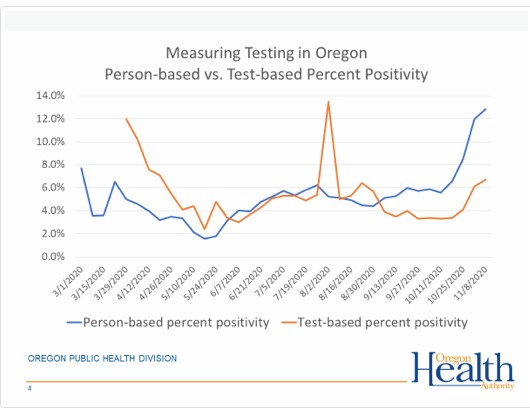
From the CDC, “Three ways in which percent positivity can be calculated for COVID-19 laboratory tests. This infographic depicts the three ways in which laboratory percent positivity may be calculated for COVID-19 laboratory tests: tests/test, people/tests, and people/people. CDC uses the test/test method, which takes the number of positive tests and divides it by the sum of the number of positive test and number of negative tests. Some states use the people/test method, which takes the number of new people with positive tests and divides it by the sum of the number of positive tests and the number of negative tests. Then other states use the people over people method, which takes the number of new people with positive tests and divides it by the sum of the number of people with positive tests and the number of people with negative tests.â€
Another thing to note is that when using the test-based system, the CDC indicates that states should not add more than one positive. For example, if the same person had a rapid test then a lab confirmed positive, it should only be reported once.
There is little chance that counting the total tests or specimens skews the data because there has to be a balance with an unknown number of false positives or positive asymptomatic tests are done on healthy individuals who are forced to screen for work or school. Whenever community prevalence is low the chance that positive results are false, is high. Remember, reported daily positive “cases†does not mean active diagnosed COVID-19 infections.

Oregon should have been using test-based calculations months ago as it’s not one size fits all in a state with varied regional demographics. Strawberry
farm workers came from California to Klamath falls and tested positive, had zero symptoms but affected the county and statewide positivity rate.
Why does it matter? Positivity rates set the ‘Phase guidance’, gym re-openings, and more. Additionally, rapid tests aren’t distinguished from the PCR tests which are known to be less accurate. We could have used targeted mitigation instead of a statewide freeze.
A D V E R T I S E M E N T
A D V E R T I S E M E N T
It is not too late. Oregon can set a new course and be a leader. State Representative Christine Drazan said this should have been our standard from the start, “The data and the science should direct our decisions but we have to have an agency that provides reliable accurate information.â€
If Oregon truly is moving toward greater transparency perhaps we can hope to see them lower the
PCR cycle thresholds and the emergency would be over before Christmas.
Has Brown’s downfall been appointing individuals ill equipped to steer the ship? Oregon’s top Epidemiologist is not trained in epidemiology but pediatrics. The director of OHA is an economist.
Hindsight is 20/20, however, what is going on at OHA?
--Nicole DeGraff| Post Date: 2020-11-21 21:08:29 | Last Update: 2020-11-23 15:47:10 |
The word “emergency†has become degraded
Oregon voters have been inundated with messaging about cataclysmic events, often right before they've been asked to grant the State more power. In 2011
Oregon voters were told that a seismic event was inevitable, tsunamis like the one that hit
Fukushima, were a certainty. Advertisements ran on radio and television warning Oregonians to have at least a month of food and water rations on hand. Many were also convinced that 2012 was the end of the world, due to a
Mayan calendar end of time. Not long after, voters were asked to pass Measure 77, a constitutional amendment that would set the stage for today's lockdowns.
Measure 77 left many things undefined, or partially defined. In the 2012 voter pamphlet, voters were given one statement in favor of the constitutional amendment, rather than full disclosure, regarding the potential for abuse of power. "The Oregon State Constitution does not provide state government the flexibility to respond quickly and appropriately to aid Oregon’s citizens should catastrophic disasters strike. We are at risk of severe natural disasters like volcanic eruptions, major flooding, earthquakes or tsunamis. Man-made catastrophes like wars and terrorism are also possible. Currently our state government lacks the constitutional authority to efficiently and effectively meet the critical needs after such an event", reads the argument supporting the measure.
"Measure 77 assures that the Governor and the Legislature will be able to work as a team to meet the urgent needs of Oregonians who have been subjected to a catastrophic disaster. We urge your “YES†vote on Measure 77."
Hysterical arguments were made in the press, to justify the alterations to Oregon's social compact and quorum requirements.
"While devastation from the earthquake and tsunami was immediate in Japan, problems arrived in slow motion in Oregon. If a major earthquake or tsunami hit here, the state constitution inadvertently would limit the governor's immediate options for response", claims the
Oregonian. Arguments circulated far and wide in support of the measure, concerns regarding travel due to floods, earthquakes and tsunamis ran rampant in the press, all justifying complete control be granted to the state, without ever considering the overreach.
Time and again, fear has been used to hoodwink voters into handing over more control. Policy decisions are being made hastily, with far reaching implications, and immediate effect. This is particularly concerning as fighting bad policy takes years, has to go through the courts, or requires a referendum from voters, assuming an emergency clause isn't attached to the bill.
After nine months, somehow, we still don't have an FDA approved viral load test, antibody test, or treatment for COVID-19. Critics are skeptical and beginning to ask questions. Dr. Henry Ealy a Portland based Doctor and professor has been working towards answers, and seeks the healing of our nation through transparency. "Why are the same people being counted multiple times as a new case?" Asks Dr. Ealy, "Why are we using PCR tests, which detect the virus’s genetic material, to make public policy when the CDC and the inventor of the test have disclaimers stating the test shouldn't be used for diagnostic purposes?"
Abusing emergency power is nothing new in Oregon, as of the 2012 legislative session over 71% of bills passed with an emergency clause attached, bypassing the voters' ability to fight back via the referendum process. "It's one thing to scare voters into handing over control during an emergency, it's quite another to perpetuate, or fabricate an emergency to suppress voters, or silence political opposition, like we've seen done with the emergency clause", says Representative Mike Nearman (R-Independence).
With Thanksgiving canceled due to case counts, not loss of life, perhaps it's time Oregonians redefine time limits, and what actually constitutes an Emergency.
 --Breeauna Sagdal
--Breeauna Sagdal| Post Date: 2020-11-21 15:51:42 | |
No arrests have been made
On November 20, 2020 at 6:45 p.m.,Portland North Precinct officers responded to the 4700 block of Northeast 106th Avenue on reports of a United Parcel Service (UPS) driver being kidnapped and robbed at gunpoint.
The UPS Driver had been delivering packages and was outside of his truck when four black male suspects confronted him. One suspect pointed a pistol at the driver demanding he give them his delivery truck. The other suspects duct-taped the UPS driver's wrists and forced him into their Honda with them. One suspect drove the UPS truck while the Honda followed. A short distance later, they stopped and the suspects stole packages from the UPS truck. The UPS driver was released unharmed. The suspects left the truck and fled in their light colored Honda.
Robbery Detectives responded to the scene and have assumed the investigation. If anyone witnessed this incident or has information about it please contact Portland Police Bureau
Robbery Detective Brett Hawkinson. or call 503-823-HELP (4357).
--Ben Fisher| Post Date: 2020-11-21 14:24:52 | Last Update: 2020-11-21 16:38:57 |
Dressed in all black and seen wearing helmets and carrying umbrellas
In the evening hours of November 20, 2020, two groups gathered separately in the city with the intent to engage in criminal behavior. The groups vandalized and destroyed private property in both Downtown and Northeast Portland.
Around 8:45 p.m., a group of nearly 30 people gathered in the South Park blocks before walking to the Mexican Consulate located in the 1300 block of Southwest 12th Avenue. Those in the group were dressed in all black and seen wearing helmets and carrying umbrellas. As the group arrived at the Mexican Consulate, they vandalized the building by spray painting it. After the group spray painted the Mexican Consulate, they headed toward the new Multnomah County Courthouse located in the 1200 block of Southwest 1st Avenue where they began to apply graffiti to the building.
Officers responded to the scene and were able to interrupt the vandalism. Units remained at the location as high visibility. Because of the high visibility, the group dispersed from the area without creating anymore damage. No arrests were made.
At around 9:15 p.m., a group of nearly 100 gathered in Northeast Portland around Northeast Halsey Street and Northeast 52nd Avenue. The group was described as wearing all black, with masks and helmets on. A 911 call came in when the group began destroying a bank located in the 4300 block of Northeast Sandy Boulevard. A cleaning crew who was inside the bank was scared as the group began to break windows to the property. Another call came in from workers inside a grocery store located in the 4300 block of Northeast Sandy Boulevard. The workers reported members of the group were shattering windows and spray painting the building.
Officers arrived in the area and observed several businesses with shattered windows and spray paint covering buildings. One business in particular appeared to have been destroyed when members of the group threw a motorized scooter through the glass windows. As officers arrived on scene, the group had dispersed on their own and no arrests were made.
At least 24 businesses were reported vandalized on Northeast Sandy Boulevard.
Persons with information are asked to contact the
police.
--Ben Fisher| Post Date: 2020-11-21 10:49:24 | Last Update: 2020-11-21 14:50:49 |
Read More Articles







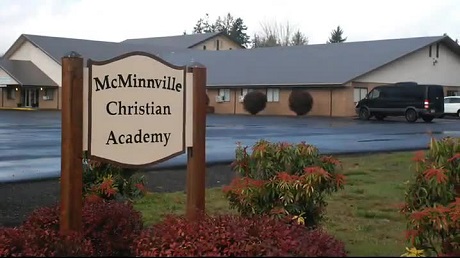

 Q. Now getting back to the Wall Street Journal editorial we've been talking about, it also states in reference to teachers unions that, quote, "under pressure from the unions, the Oregon Department of Education stopped allowing transfers on March 27," end quote. Is that true? What I want to know is, first, did you ever get pressure from the teachers unions to stop allowing transfers out of public schools?
Q. Now getting back to the Wall Street Journal editorial we've been talking about, it also states in reference to teachers unions that, quote, "under pressure from the unions, the Oregon Department of Education stopped allowing transfers on March 27," end quote. Is that true? What I want to know is, first, did you ever get pressure from the teachers unions to stop allowing transfers out of public schools? Q. Have you ever heard Leah Horner make any statement or write any statement like that?
Q. Have you ever heard Leah Horner make any statement or write any statement like that? Q. Okay. And as best you can recall, what questions did she ask along that line?
Q. Okay. And as best you can recall, what questions did she ask along that line?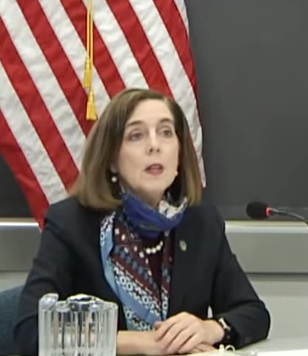





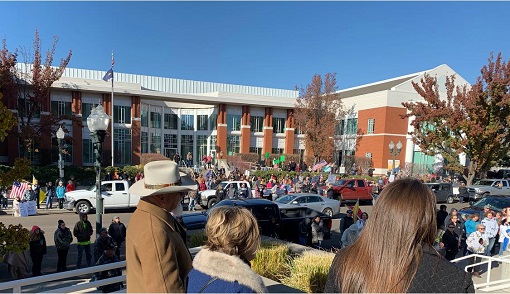
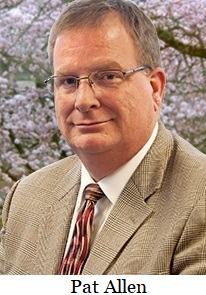
 What this means and why this matters follows this important detail: Schools could have been open since early September when testing capacity was first ramped up. Schools could have been open in-person for two months as each district had to submit their reopening plans based on metrics which included statewide and county positivity rates. In September, the positivity rate for the state was 4%. If OHA had chosen to use the test-based measurement the CDC allowed for, schools could have been open. Many do not know this but once a school was in-person it could remain in-person even if community cases were increasing unless there was an outbreak in the actual school itself. OHA just removed this metric on October 28th. Was this an early indicator that their testing methods were flawed, yet they instituted a freeze anyway?
What this means and why this matters follows this important detail: Schools could have been open since early September when testing capacity was first ramped up. Schools could have been open in-person for two months as each district had to submit their reopening plans based on metrics which included statewide and county positivity rates. In September, the positivity rate for the state was 4%. If OHA had chosen to use the test-based measurement the CDC allowed for, schools could have been open. Many do not know this but once a school was in-person it could remain in-person even if community cases were increasing unless there was an outbreak in the actual school itself. OHA just removed this metric on October 28th. Was this an early indicator that their testing methods were flawed, yet they instituted a freeze anyway?
 From the CDC, “Three ways in which percent positivity can be calculated for COVID-19 laboratory tests. This infographic depicts the three ways in which laboratory percent positivity may be calculated for COVID-19 laboratory tests: tests/test, people/tests, and people/people. CDC uses the test/test method, which takes the number of positive tests and divides it by the sum of the number of positive test and number of negative tests. Some states use the people/test method, which takes the number of new people with positive tests and divides it by the sum of the number of positive tests and the number of negative tests. Then other states use the people over people method, which takes the number of new people with positive tests and divides it by the sum of the number of people with positive tests and the number of people with negative tests.â€
From the CDC, “Three ways in which percent positivity can be calculated for COVID-19 laboratory tests. This infographic depicts the three ways in which laboratory percent positivity may be calculated for COVID-19 laboratory tests: tests/test, people/tests, and people/people. CDC uses the test/test method, which takes the number of positive tests and divides it by the sum of the number of positive test and number of negative tests. Some states use the people/test method, which takes the number of new people with positive tests and divides it by the sum of the number of positive tests and the number of negative tests. Then other states use the people over people method, which takes the number of new people with positive tests and divides it by the sum of the number of people with positive tests and the number of people with negative tests.â€
 Oregon should have been using test-based calculations months ago as it’s not one size fits all in a state with varied regional demographics. Strawberry farm workers came from California to Klamath falls and tested positive, had zero symptoms but affected the county and statewide positivity rate.
Oregon should have been using test-based calculations months ago as it’s not one size fits all in a state with varied regional demographics. Strawberry farm workers came from California to Klamath falls and tested positive, had zero symptoms but affected the county and statewide positivity rate.



